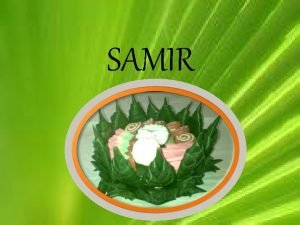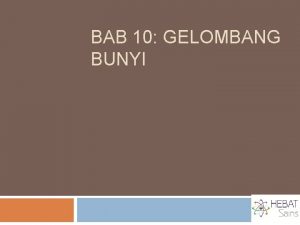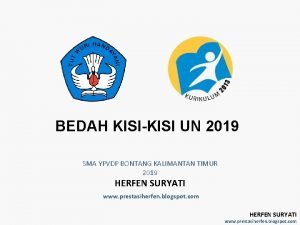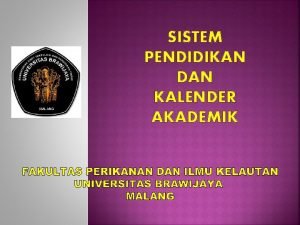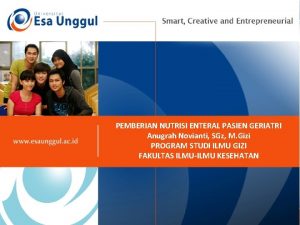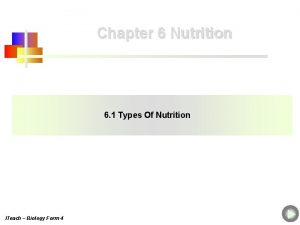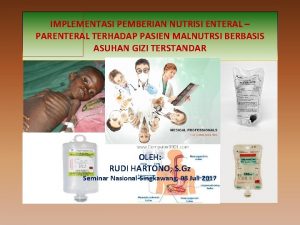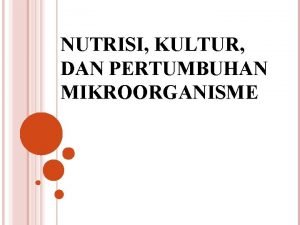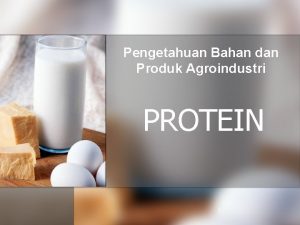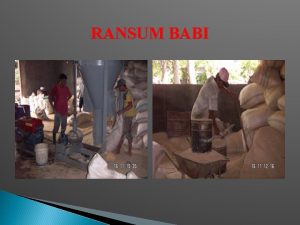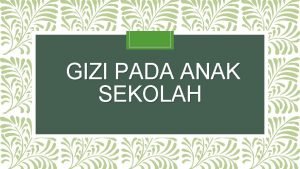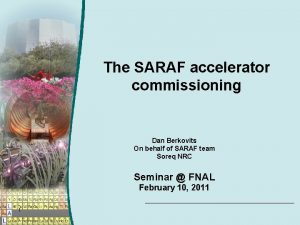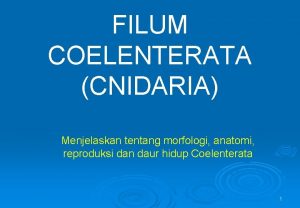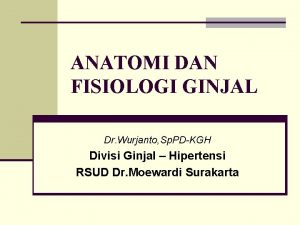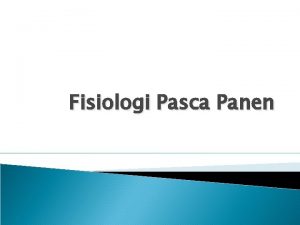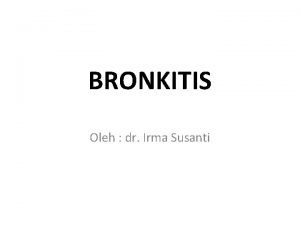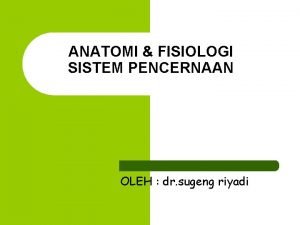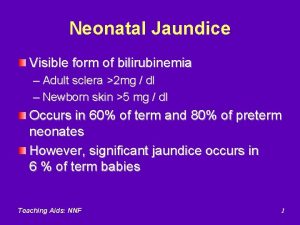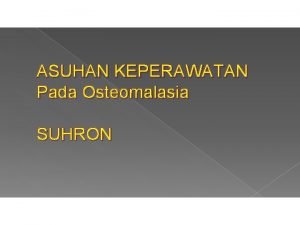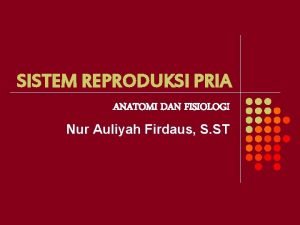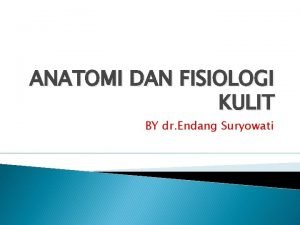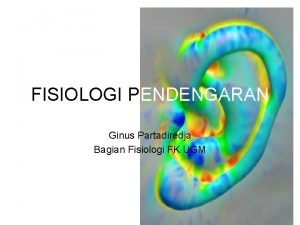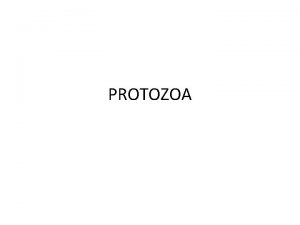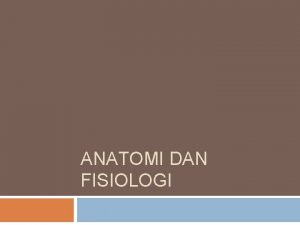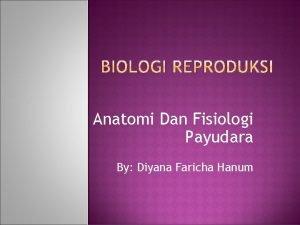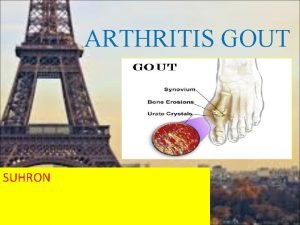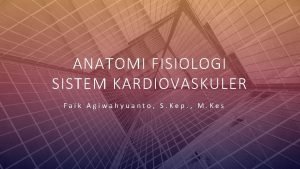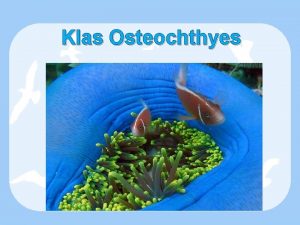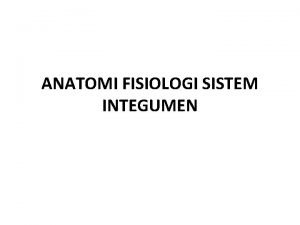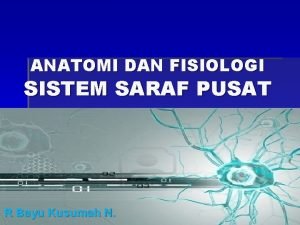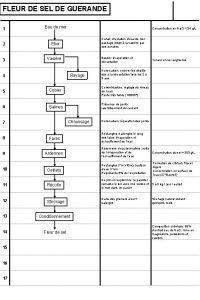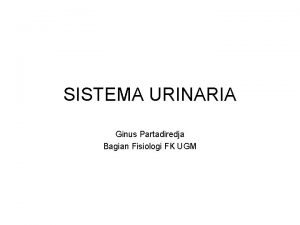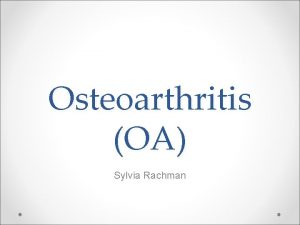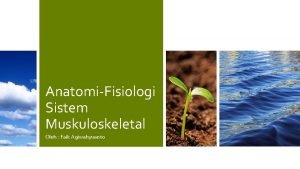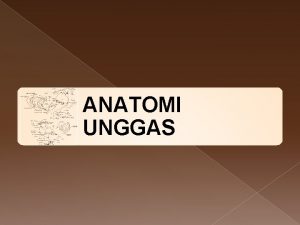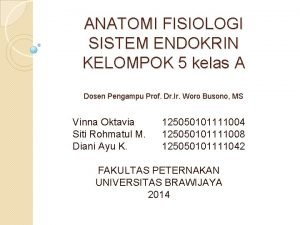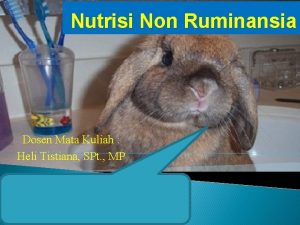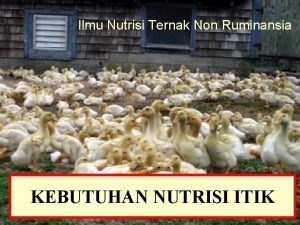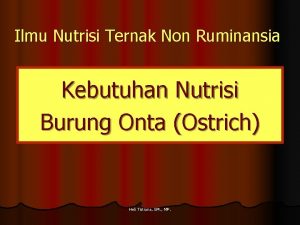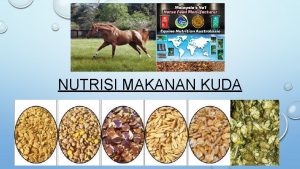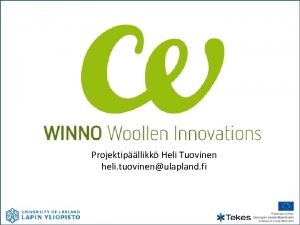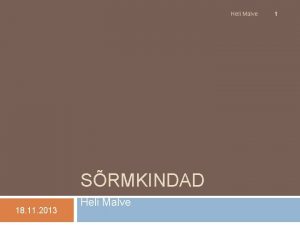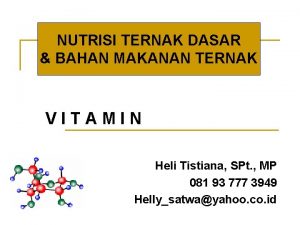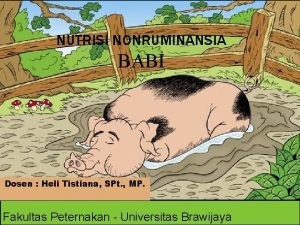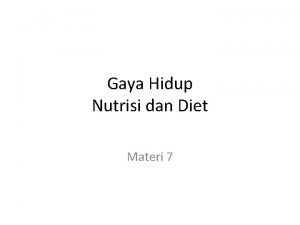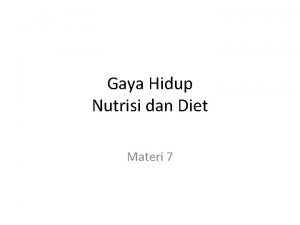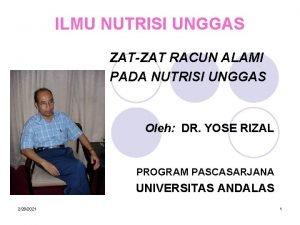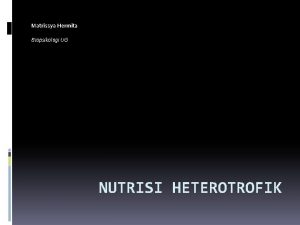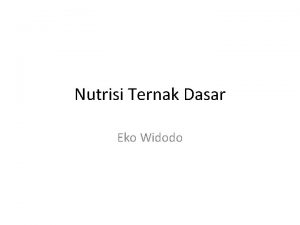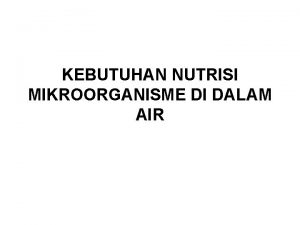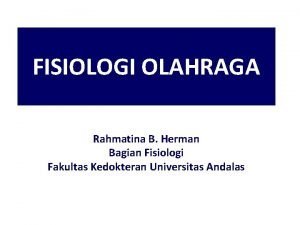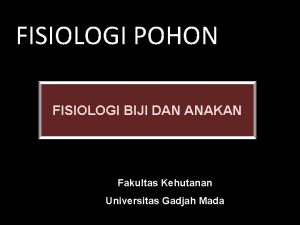FISIOLOGI NUTRISI KUDA Mk Nutrisi Non Ruminansi Heli












































- Slides: 44

FISIOLOGI NUTRISI KUDA Mk. Nutrisi Non Ruminansi Heli Tistiana, SPt. , MP. 081 2332 2232

Sistem pencernaan Kuda 1. Saluran Pencernaan a. Mulut b. farings c. Esophagus d. Lambung e. Usus Kecil f. Usus Besar 2. Organ Pelengkap a. Gigi b. Lidah c. Kelenjar Air Liur d. Hati e. Pankreas

Mulut • Saat pakan awal • Sekresi Saliva dari kelenjar parotis Mengeluarkan air liur hanya selama makan, ~ 10 gal / hari

Kelenjar Saliva 1. 2. 3. Kelenjar parotis Kelenjar mandibularis/submaksilaris Kelenjar lingualis Tugas 1 : Apa Fungsi dari Kelenjar Saliva dan peranan masing kelenjar air liur diatas pada ternak kuda

Anatomy of Digestive Tract

Digestive Tract Pharings dan Esophagus Farings berperan untuk menyambung rongga mulut dan esophagus Panjang esophagus sekitar 125 -150 cm

Lambung Ukuran kecil, sering, makanan, memulai pencernaan, seperti non-ruminansia 10% dari saluran Terbatas pencernaan Tukak Lambung

Small Intestine - 30% of tract Digestion of Starch 65 -75% Protein, AA’s 60 -70% Fat 90% Ca absorption 95 -99% Phosphorous 20 -25% Fast rate of passage No gall bladder

Large Intestine Large Colon Absorbs H 2 0 VFA’s AA Phosphorus, 50% Na. Cl Small Colon Absorption of H 20 Fecal ball formation

Comparisons of digestion Human Ruminant Equine Stomach 30% 70% 9 -10% Sm. Intestine 33% 19% 30% Cecum 7% 3% 16% Lg. Intestine 30% 7% 45%

Perbandingan Kapasitas Saluran Pencernaan (liter) Kuda Sapi Babi - 200 - Lambung 17, 6 15, 4 7, 7 Usus Kecil 66 68, 4 9, 9 Sekum 82, 5 9, 9 1, 1 Kolon dan Rektum 15, 5 28, 6 8, 8 Jumlah 181, 5 342, 1 27, 5 Rumen-Retikulum. Omasum

Kapasitas Saluran Pencernaan capacity 9% 8% Stomach 30% Small Intestine Cecum large Colon 38% Small Colon 15%


Pencernaan Nutrisi Kuda herbivora monogastrik - perut sederhana, makan tanaman • hindgut fermentor - pencernaan serat pada LI • Pencernaan dan penyerapan bahan pakan nonfibrous (Protein, lemak, gula, pati, air, vitamin, mineral) di perut dan SI - FOREGUT • Pencernaan dan fermentasi bahan pakan berserat (Selulosa dan hemiselulosa) dalam sekum dan usus besar oleh bakteri dan penyerapan VFA, air, amonia, mineral, vitamin – hindgut Foregut : 38% Hind. Gut : 62%


Air Penting untuk semua fungsi tubuh Suhu Feed pencernaan Jumlah asupan air Tingkat latihan Kualitas pakan dalam ransum Proporsi diet hijauan Minimal 1 gallon/100 lbs BW / hari

GI Tract Health Forage Concentrate – Grain Supplements

Digestion of Feed Stomach Small Intestine Large Intestine Fermentable Fiber Fat Digestible Carbohydrate Fatty Acids Glucose Fat Glycogen Volatile Fatty Acids

Kategori Pencernaan Kuda Maintenence - dasar persyaratan kehidupan Pertumbuhan - termuda memiliki persyaratan tertinggi Kehamilan - tiga bulan terakhir Laktasi - tiga bulan pertama Pekerjaan - tergantung pada aktivitas ringan, sedang, intens Tugas 2 : Bagaimana pencernaan kuda pada masing-masing kategori/periode ini

Maintenance Size: body weight Environment Individual digestive & metabolic efficiency Dry matter intake: 1. 5% of the BW Most - energy requirements are met with forage alone

GERIATRIC HORSES Fiber digestion decreases Ability to manufacture or absorb certain vitamins decrease B vitamins Vitamin C Decreased kidney function Calcium stones may build up Decreased liver function Jaundice, weight loss, lethargy, loss of appetite, intolerance for fat and protein in diet

THE GERIATRIC HORSE Confinement? No! Turnout with a friend. Weight loss reasons: Poor dentition Reduction in digestion - parasites, microbial constituents, B Vits Selection of Feed Highly palatable Easy to chew & swallow Clean & dust free Highly digestible pellets or extruded feeds Contain enough high quality fiber to aid digestion. High quality hay – no alfalfa. Chopped hay, hay cubes or pellets Soaked feeds or mashes

Feeding The Athlete

Levels of Performance/Work Light - western and English pleasure, trail riding, equitation, hacking Moderate - dressage, ranch work, roping, cutting, barrel racing, jumping Intense - race training, polo, cutting,

SOURCES OF ENERGY FOR THE PERFORMANCE HORSE Muscle Glycogen Blood Glucose Creatine Phosphate Free-Fatty Acids Anaerobic Glycolysis Pyruvate ATP Myokinase and CPK Reactions Lipolysis Lactate Oxidative Metabolism Oxygen CO 2 and Water

HORSE DIET BASICS 1. Water intake 2. Maximize forage intake 3. Minimize concentrate consumption 4. Balance the ration in the following order (a)energy (b) protein (c) minerals (d) vitamins 5. Monitor body weight & body condition score 6. Change feedstuffs gradually (7‐ 14 days) 7. Calcium to phosphorus should be between 3: 1 to 1: 1 8. Supplement minerals & vitamins 9. Feed each horse as an individual

Energy Sources Hydrolysable CHO Sugars & starches Create ↓ intestinal p. H & risk of colic Fermentable CHO Beet pulp or soy hulls ↓ glycogen usage Fat 3 X the energy concentration of CHO Creates higher energy feed Protein (minimal usage)

Required Energy Activity Examples DE (Mcal/d) Maintenance Pasture 16 Light work Pleasure riding 20 Moderate work Reining, jumping 24 Intense work Racing, endurance 32

FAT SUPPLEMENTATION l Why Use It For Performance Horses? l Energy from fat is 90% utilizable l Fat ↓ heat of fermentation l Fat glycogen storage prior to race l Fat ↓ buildup of lactic acid during intense exercise l Fat ↓ fatigue

Sources of Fat l Natural horse diets contain < 3 -4% fat l “High Fat” sweet feeds contain 6 -10% fat l Fat Supplements l Vegetable Oil (most common 99% fat) l Rice Bran (very palatable 20% fat) l Animal tallow (not palatable)

Fat Guidelines No gall bladder Max ~20% in total diet 1100 lb horse can digest 17. 5 oz of fat (Just over 2 cups) If adding fat to existing diet, need to rebalance other nutrients (i. e. vitamin E (200 IU/cup of added oil) Add 6 -10 weeks before performance.

General Guidelines For Feeding Working Horses Hay requirement Feed at least 50% of total ration as forage (pasture &/or hay) Preferably high quality grass hay or alfalfa/grass mix Exercising horses do not need high levels of protein More important – quality of protein Horses should be fed to meet their immediate needs I. e. cut grain on rest days If stalled, overfeeding can stocking up or colic

The Growing Horse Goals Maximize genetic potential for growth Sound musculoskeletal system • Nutrient balance is important • Requires higher quality feeds • Growth rate & age determines requirements • Growing till reach 30 months

Percent of Mature Body Weight vs. . . Months of Age Light Horse Draft 100 90 80 70 60 50 40 30 20 10 0 % 6 12 18 24 Months of Age 30 Percent of Mature Height vs. . Months of Age 36 98 96 94 92 90 88 86 84 82 80 6 12 18 Months of Age 24

Weanlings Minimize stress Minimize post-weanling slump. 1. 5 -2. 5 lbs grain/100 lbs body wt 0. 75 -1. 0 lb hay/100 lb body wt Ca > P Monitor feed & water intake

As foals get older, the ration should be increased by adding more good quality hay, leaving the grain mix relatively constant.

Feeding Yearlings Sales/show Forage �High quality �. 75 -1. 0 lb/100 lb body wt. Concentrate �Formulated for growth � 1. 0 -2. 0 lb/100 lb body wt. l Turnout – Forage l l – High to moderate quality 2 -2. 5 lbs. /100 lbs. body wt. Forage balancer

Monitoring The Growth Process Daily Intakes Body Weight Average daily gain Signs of Skeletal Abnormalities Physitis Joint effusion Lameness

Nutrition of The Broodmare Lactation 0 -3 months 4+ months Months 0 -8 Months 9 -11 Gestation

Gestation: Nutritional Concerns Provision of nutrients for: Fetal growth & development Other products of conception Foal 10% 85% • Last 3 month of gestation: 60 % foals’ weight • Mare needs to gain 0. 3 – 0. 8 lb/d Other 5%


Average daily milk production in mares Daily Milk Production (lbs) 28 27 26 25 24 23 22 21 15 30 45 60 Time (days) 90 120 150

Feed Consumption (% BW) Mare status Forage Concentrate Total Early pregnancy 1. 5 -2. 0 0 -0. 5 1. 5 -2. 0 Late pregnancy 1. 0 -1. 5 0. 5 -1. 0 1. 5 -2. 0 Early lactation 1. 0 -2. 0 -3. 0 Late lactation 1. 0 -2. 0 0. 5 -1. 5 2. 0 -2. 5 • Adding concentrate to late pregnancy mares accounts for limited energy & acclimates microbes • Allow 1 wk to 10 d for mares to adjust to intake changes • Heavy milkers may require as much as 1. 75 -2. 0% of BW in concentrate feed/day

Nutrition of the Breeding Stallion Primary Concern l Maintenance of Body Non-breeding – Condition l Forage + vitamin/mineral supplement Breeding – – 0. 5% concentrate 1. 75 -2% hay
 Lipatan daun tum
Lipatan daun tum Julat pendengaran kuda
Julat pendengaran kuda Teracak kuda
Teracak kuda Embriologi perbandingan
Embriologi perbandingan Kata fosil berasal dari kata fodere yang berarti
Kata fosil berasal dari kata fodere yang berarti Quand le ciel est bleu mon garçon
Quand le ciel est bleu mon garçon Nutrisi ikan
Nutrisi ikan Diet enteral adalah
Diet enteral adalah Kepentingan makronutrien terhadap tumbuhan
Kepentingan makronutrien terhadap tumbuhan Nutrisi enteral dan parenteral
Nutrisi enteral dan parenteral Nutrisi yang dibutuhkan manusia
Nutrisi yang dibutuhkan manusia Kebutuhan nutrisi ternak unggas
Kebutuhan nutrisi ternak unggas Tabel kebutuhan nutrisi ternak ruminansia
Tabel kebutuhan nutrisi ternak ruminansia Sni pakan babi
Sni pakan babi Pengertian gizi anak sekolah
Pengertian gizi anak sekolah Fisiologi saraf
Fisiologi saraf Anatomi fisiologi sistem reproduksi wanita
Anatomi fisiologi sistem reproduksi wanita Reproduksi aseksual cnidaria
Reproduksi aseksual cnidaria Fisiologi biji
Fisiologi biji Anatomi fisiologi ginjal
Anatomi fisiologi ginjal Fisiologi pasca panen adalah
Fisiologi pasca panen adalah Anatomi fisiologi bronkitis
Anatomi fisiologi bronkitis Anatomi dan fisiologi sistem pencernaan
Anatomi dan fisiologi sistem pencernaan Fisiologi bilirubin
Fisiologi bilirubin Fisiologi tulang
Fisiologi tulang Anatomi fisiologi sistem endokrin
Anatomi fisiologi sistem endokrin Anatomi genitalia pria
Anatomi genitalia pria Anatomi dan fisiologi kulit
Anatomi dan fisiologi kulit Fisiologi pendengaran
Fisiologi pendengaran Morfologi protozoa
Morfologi protozoa Definisi anatomi dan fisiologi manusia
Definisi anatomi dan fisiologi manusia Struktur payudara dan fisiologi laktasi
Struktur payudara dan fisiologi laktasi Fisiologi laktasi
Fisiologi laktasi Anatomi fisiologi gout arthritis
Anatomi fisiologi gout arthritis Kontrol intrinsik dan ekstrinsik jantung
Kontrol intrinsik dan ekstrinsik jantung Osteichthyes
Osteichthyes Anatomi fisiologi sistem integumen
Anatomi fisiologi sistem integumen Anatomi fisiologi sistem saraf pusat
Anatomi fisiologi sistem saraf pusat Fisiologi
Fisiologi Elektrolit
Elektrolit Anatomi ginjal
Anatomi ginjal Fisiologi tulang
Fisiologi tulang Gambar anatomi fisiologi sistem muskuloskeletal
Gambar anatomi fisiologi sistem muskuloskeletal Anatomi tulang ayam
Anatomi tulang ayam Pengertian sistem endokrin
Pengertian sistem endokrin
